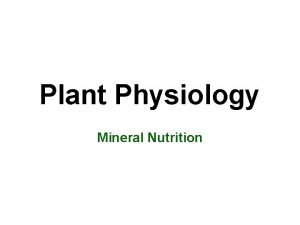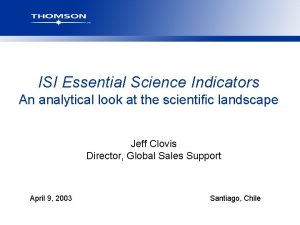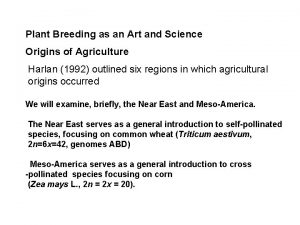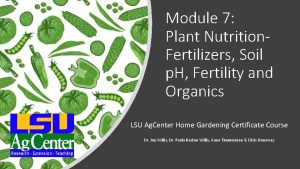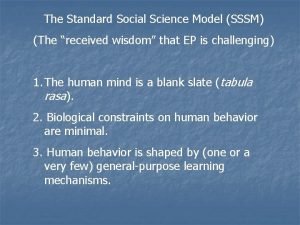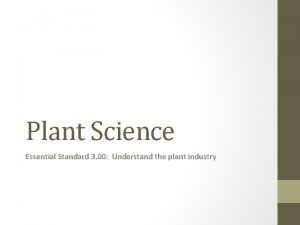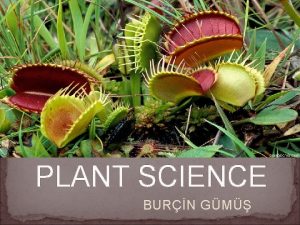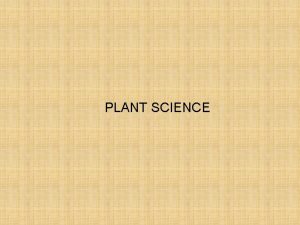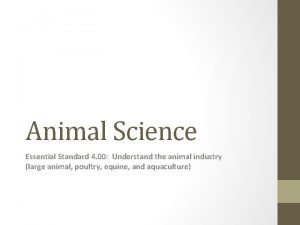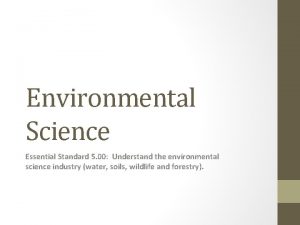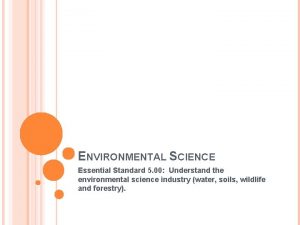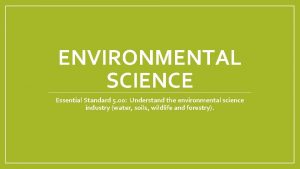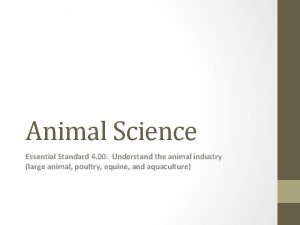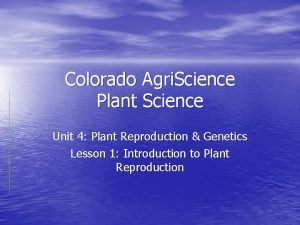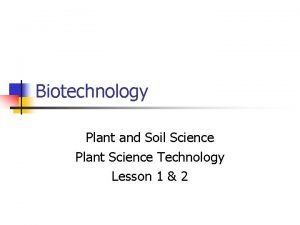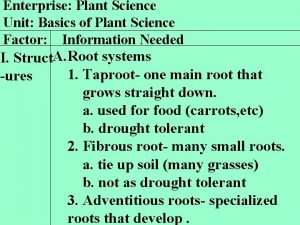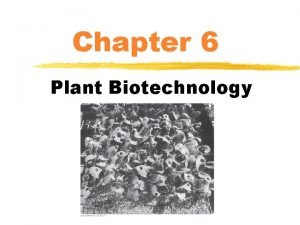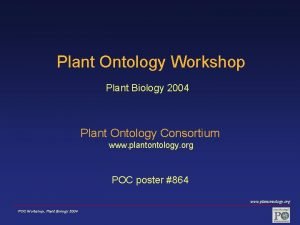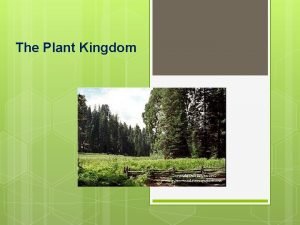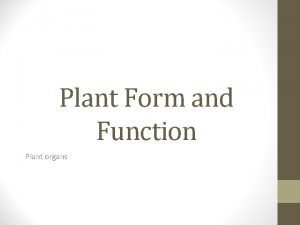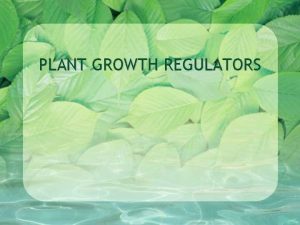Plant Science Essential Standard 3 00 Understand the




























































- Slides: 60

Plant Science Essential Standard 3. 00: Understand the plant industry

Objective 3. 01 • Remember careers in the plant industry.

Major Plant Science Industries: • Ornamental Horticulture • The science and art of producing, processing, marketing and distributing plants grown for their appearance or beauty • Examples • • • Flowers Shrubs Trees Grasses Interior plants

Major Plant Science Industries: • Fruit and Vegetable Production • The science and art of producing, processing, marketing and distributing fruits and vegetables • Examples: • • • Blueberries Apples Peaches Strawberries Tomatoes Cucumbers Sweet corn Squash Sweet potatoes

Major Plant Science Industries: • Agronomy • The science of soil management and crops. • Examples • • • Wheat Barley Field corn Soybeans Cotton

Examples of Ornamental Horticulture Careers • Florist • designs and arranges cut flowers • Groundskeeper • maintains lawn and landscape areas • Landscape Architect • a professional trained in the art and science of arranging land objects upon it • Golf Course Superintendent • manages the golf course grounds

Examples of Ornamental Horticulture Careers • Nursery Operator • manages a business that grows and sells trees, shrubs and other ornamental plants • Greenhouse Manager • manages a business that grows and sells greenhouse plants • Gardener • a person who grows and maintains plants for estates, institutions, etc. • Landscape Contractor • a person licensed to install landscapes based on passing certification exams

Examples of Fruit and Vegetable Careers • Vegetable Grower • grows and sells vegetables for the fresh, wholesale and retail markets • Produce Manager • manages retail produce departments of grocery stores • Winery Supervisor • manages the production of wines

Examples of Agronomy Careers • Agronomist • a specialist in soil and crop sciences • Forage Manager • grow, manage and sell hay crops for various animal producers • Federal grain Inspector • Federal employee that inspects harvested grain crops

Examples of General Plant Science Careers • Plant Physiologist • person who studies plant processes and functions • Plant Breeder • person who develops new plants through, selection, hybridization, etc • Plant Propagator • a person who reproduces plants • Entomologist • a person who studies insects

Objective 3. 02 • Understand biotechnology in the plant industry.

Biotechnology Basics • Biotechnology is the use of living organisms (microorganisms) to make new products or carry out new processes (solve problems). • New product – Yogurt • New Process –Tissue culture • propagation method that rapidly multiplies plants

Historic Applications of Biotechnology • Yeast to make bread rise • Bacteria to produce cheeses and other dairy products • Microorganisms to transform fruit or grains into alcoholic beverages • Use of bacteria to “produce” silage • E. coli bacteria used to produce insulin • It became one of the first commercial products created by genetic engineering

Silage

Basic Genetics • The science of heredity • Gregor Johann Mendel • discovered the effect of genetics on plant characteristics with his experimentation with garden peas • Heredity • transmission of characteristics from an organism to its offspring through genes in reproductive cells • Genes • determine the individual characteristics of living things • segments of double stranded DNA • Generation • the offspring, or progeny, of common parents

Basic Genetics • DNA –Genetic Code of Life • Chromosome • a structure that holds the genetic information of a cell • DNA is wound tightly to form the chromosome • DNA (deoxyribonucleic acid) • coded material in all cell nuclei • determines what that cell and its successive cells will become • structure is that of a twisted ladder • double helix

Basic Genetics • Gene • small section of DNA • thousands of genes on a strand of DNA • Gene mapping • process of both finding and recording the locations of genes

Basic Genetics • Bases • Like rungs of a ladder that hold the two sides of the DNA strands together. • The bases are: • • Adenine (A) - only pairs with “T” Thymine (T) – only pairs with “A” Guanine (G) – only pairs with “C” Cytosine (C) – only pairs with “G” • Example: • A – T • G – C • T - A • The sequence of the bases between the DNA strands is the code by which a gene controls a specific trait • Baldness in humans • The color of flowers on a plant

Processes and Practices in biotechnology • Genetic engineering • developed in the early 1980’s • process of moving genetic information in the form of genes from one cell to another • Gene splicing or Recombinant DNA technology • process of removing and inserting genes from one organism and inserting them into the DNA of another • Some examples are: • Alter a plant’s susceptibility to disease • Make a plant resistant to insects • Process in animals is newer and not as well developed

Processes and Practices in biotechnology • Cloning (micropropagation in plants) • creating an exact genetic duplicate of another organism • Indicator species • one of the oldest methods of biological detection. • uses plants, animals and microbes to warn us about pollutants in the environment

Processes and Practices in biotechnology • Bioremediation • use living organisms to clean up toxic wastes in water and soil • Biostimulation • Adding nutrients such as nitrogen and phosphorus to stimulate the growth of naturally occurring beneficial microbes • faster more efficient work

Processes and Practices in biotechnology • Phytoremediation • plant absorbs or immobilizing pollutants • First tested in the 1990’s • Animal Reproduction and Production • improving the efficiency of reproduction and production involve the use of biotechnology • These are considered the more conventional uses of biotechnology • Biofuels • Fuels composed of or produced from biological raw materials

Importance of Recombinant DNA Technology • Improve plants’ and animals’ performance • The manipulation of genes • Alter characteristics or performance of microorganisms • Controlling disease, insects, weeds, and other pests • Less use of chemical pesticides • Potential for helping clean the environment

Concerns with the use of Biotechnology • Safety • State and federal government monitor • Consumer resistance to new biotech food products remains high • safety of the environment • human health concerns • Rapidly changing field, which when not fully understood • can create a fear of the unknown • Labeling of genetically modified organisms (GMO) foods • many people feel if a product is safe it should be labeled • Concern has been expressed over the effect GMO’s may have on biodiversity

Concerns with the use of Biotechnology • Ethics • system of moral principles • defines what is right and wrong in a society • raises important ethical questions about how biotechnology should be used

Scientific Method used in Biotechnology/Agriscience • Steps of the scientific method: 1. 2. 3. 4. 5. 6. 7. 8. Identify the problem Review literature Form a hypothesis Prepare a project proposal Design the experiment Collect the data Draw conclusions Prepare a written report

Biotechnology in the plant science industry • Herbicide and insect resistant crops • Examples: • Herbicide tolerant soybean (Round-Up Ready Soybeans) • contains a gene that provides resistance to broad spectrum herbicides • Others being developed • Insect- resistant corn (Bt corn) • contains a built-in insecticidal protein • from a naturally occurring soil microorganism • Bacillus thuringiensis • gives season- long control of corn borers •

Biotechnology in the plant science industry • Crops with better nutrition and longer shelf life are products of genetic engineering • High Oleic Peanut • genetically modified to produce nuts in high oleic acid • longer life for nuts, candy and peanut butter • High Oleic Sunflower • sunflower oil that is low in trans-fatty acids • Delayed- ripening tomato • longer shelf life • commercial advantages in harvesting and shipping

Biotechnology in the plant science industry • Tissue culture • Micropropagation • use of a very small actively growing parts of the plant • produces a large number of new plants • African violets

Objective 3. 03 • Understand basic horticultural (ornamental, fruit and vegetable) and agronomic principles and practices.

Type of Plant Growing Media • Soil is the top layer of the Earth’s surface and is the primary medium of cultivated plants • Topsoil • Subsoil • Parent material

Type of Plant Growing Media • Sphagnum moss • used for encouraging root growth under certain conditions • Peat moss • consists of partial decomposed mosses in waterlogged areas called bogs

Type of Plant Growing Media • Perlite • volcanic glass material • has water-holding capabilities • used for starting new plants and in media mixes • Vermiculite • mineral- type mica • used for starting plant seeds and cuttings and in media mixes

Amending the Plant Growing Media • Add organic matter • Specific nutrients • Modify soil p. H • Improper p. H will impact the availability of nutrients • measure of the degree of acidity or alkalinity • p. H scale ranges from 0 -14 • high alkalinity are made more acidic (lowering the p. H) by adding sulfur or aluminum sulfate • high acidic level is made more alkaline (raising the p. H) by adding lime • finely ground dolomitic limestone • supplies both Ca (calcium) and Mg (magnesium)

Fertilizers • Complete fertilizer • Contains the three primary nutrients • N (nitrogen) • P (phosphorus) • K (potassium) • Organic fertilizers • made with plant or animal products • Dried cow manure • Bone meal (high in phosphorus) • Blood meal • slow acting and long lasting forms of N • lacking in the other primary nutrients (except bone meal) • Inorganic fertilizers • higher analysis of soluble nutrients • blended together for a specific purpose

Fertilizer Application • Broadcasting • evenly spreading over the entire surface of a lawn or other growing area • Side-dressing • placing fertilizer in bands about 8” from the row of growing plants • popular for field crops like corn and soybeans • Foliar application • spraying of liquid fertilizer directly onto the leaves of plants

Broadcasting

Side Dressing

Principle Parts of Plants • Roots • Generally two types • Fibrous • tap root • Function • anchor the plant • take in water and nutrients

Principle Parts of Plants • Stems • Two basic types of aboveground stems • Woody • Herbaceous • Supports other plant parts • Water and nutrients are carried up to the leaves • Sugar made in the leaves is transported down to the roots

Principle Parts of Plants • Leaves • manufactures food for the plant by using light energy (photosynthesis) • The chemical equation for photosynthesis is: light energy 6 CO 2 + 6 H 2 O = C 6 H 1206 + 6 02 Chlorophyll • Occurs best in a temperature range of 65 -85 degrees F • Leaves are very useful in identifying plants and vary greatly • leaf margin (edge), shape and arrangement are all important in plant identification

Principle Parts of Plants • Flowers • • • The primary function is the production of seed Male flower part is the stamen (anther, filament) Female part is the pistil (stigma, style, ovary). Can be male, female or both Petals attract insects to aid in pollination

Flower Parts

Principle Parts of Plants • Fruit • The ovary (lower part of the pistil) of a flower matures into a fruit that surrounds the seeds • Seed develops in the female part (pistil) of the flower • The seed has 3 basic parts: • Seed coat- protection for the seed • Endosperm – food for the seed • Embryo – baby plant

Common Plant Science Skills • Transplanting • Can be done by hand or machine • Involves moving a young plant from one location to another. • Example: a seedling tomato from a cell pack in the greenhouse into a home garden

Common Plant Science Skills • Propagation • Increasing the number of a plant species • Sexual • is the use of seeds for reproducing plants • Asexual (vegetative) • use of a part or parts of a plant for reproducing plants • results in an exact duplication of the parent plant

Asexual Propagation 1. Cuttings (stem) • • Vegetative parts that the parent plant uses to regenerate itself. Rooting hormones are often applied to speed up the development of roots 2. Division • A method of dividing or separating the main part of a plant into smaller parts 3. Grafting • method of joining two plants together to grow as one 4. Tissue culture • use of a very small piece of a plant (explant) to produce a large number of new genetically identical plants

Objective 3. 04 • Remember tools and their safety practices related to the plant industry.

Plant Science Related Tool Safety Concepts 1. Choosing the right tool for a job • promote safety in the shop and workplace 2. Caring for tools and keeping them in good working condition • promote safety in the shop and workplace

Plant Science Related Tools • Bulb planter • planting and transplanting bulbs

Plant Science Related Tools • Grafting tool • preparing woody parts for grafting

Plant Science Related Tools • Hose bib • valve for attaching a water hose and turning water supply on and off

Plant Science Related Tools • Lopping shears • Cutting large branches when pruning shrubbery.

Plant Science Related Tools • Pruning saw • sawing limbs from shrubbery and trees

Plant Science Related Tools • Pruning shears • cutting and shaping shrubbery

Plant Science Related Tools • Hedge shears • trimming and shaping shrubbery

Plant Science Related Tools • Soil auger • boring into soil to get samples

Plant Science Related Tools • Soil thermometer • determining soil temperatures

Plant Science Related Tools • Soil tube • obtaining soil for testing

Plant Science Related Tools • Water breaker • reduces the impact of water pressure on soil and plants
 To understand recursion you must understand recursion
To understand recursion you must understand recursion Characteristics of lipids
Characteristics of lipids Mathematics ____ my favorite subject
Mathematics ____ my favorite subject Essential plant nutrients definition
Essential plant nutrients definition Isi essential science indicators
Isi essential science indicators Ncdpi science standards
Ncdpi science standards Intraspecific hybridization
Intraspecific hybridization Taichum
Taichum Plant introduction in plant breeding
Plant introduction in plant breeding Tronsmo plant pathology and plant diseases download
Tronsmo plant pathology and plant diseases download Tronsmo plant pathology and plant diseases download
Tronsmo plant pathology and plant diseases download Tronsmo plant pathology and plant diseases download
Tronsmo plant pathology and plant diseases download Hình ảnh bộ gõ cơ thể búng tay
Hình ảnh bộ gõ cơ thể búng tay Slidetodoc
Slidetodoc Bổ thể
Bổ thể Tỉ lệ cơ thể trẻ em
Tỉ lệ cơ thể trẻ em Gấu đi như thế nào
Gấu đi như thế nào Thang điểm glasgow
Thang điểm glasgow Hát lên người ơi alleluia
Hát lên người ơi alleluia Môn thể thao bắt đầu bằng chữ đua
Môn thể thao bắt đầu bằng chữ đua Thế nào là hệ số cao nhất
Thế nào là hệ số cao nhất Các châu lục và đại dương trên thế giới
Các châu lục và đại dương trên thế giới Công thức tính thế năng
Công thức tính thế năng Trời xanh đây là của chúng ta thể thơ
Trời xanh đây là của chúng ta thể thơ Mật thư anh em như thể tay chân
Mật thư anh em như thể tay chân Làm thế nào để 102-1=99
Làm thế nào để 102-1=99 Phản ứng thế ankan
Phản ứng thế ankan Các châu lục và đại dương trên thế giới
Các châu lục và đại dương trên thế giới Thơ thất ngôn tứ tuyệt đường luật
Thơ thất ngôn tứ tuyệt đường luật Quá trình desamine hóa có thể tạo ra
Quá trình desamine hóa có thể tạo ra Một số thể thơ truyền thống
Một số thể thơ truyền thống Cái miệng nó xinh thế chỉ nói điều hay thôi
Cái miệng nó xinh thế chỉ nói điều hay thôi Vẽ hình chiếu vuông góc của vật thể sau
Vẽ hình chiếu vuông góc của vật thể sau Nguyên nhân của sự mỏi cơ sinh 8
Nguyên nhân của sự mỏi cơ sinh 8 đặc điểm cơ thể của người tối cổ
đặc điểm cơ thể của người tối cổ Thế nào là giọng cùng tên? *
Thế nào là giọng cùng tên? * Vẽ hình chiếu đứng bằng cạnh của vật thể
Vẽ hình chiếu đứng bằng cạnh của vật thể Phối cảnh
Phối cảnh Thẻ vin
Thẻ vin đại từ thay thế
đại từ thay thế điện thế nghỉ
điện thế nghỉ Tư thế ngồi viết
Tư thế ngồi viết Diễn thế sinh thái là
Diễn thế sinh thái là Dạng đột biến một nhiễm là
Dạng đột biến một nhiễm là Số nguyên tố là
Số nguyên tố là Tư thế ngồi viết
Tư thế ngồi viết Lời thề hippocrates
Lời thề hippocrates Thiếu nhi thế giới liên hoan
Thiếu nhi thế giới liên hoan ưu thế lai là gì
ưu thế lai là gì Sự nuôi và dạy con của hổ
Sự nuôi và dạy con của hổ Khi nào hổ con có thể sống độc lập
Khi nào hổ con có thể sống độc lập Hệ hô hấp
Hệ hô hấp Từ ngữ thể hiện lòng nhân hậu
Từ ngữ thể hiện lòng nhân hậu Thế nào là mạng điện lắp đặt kiểu nổi
Thế nào là mạng điện lắp đặt kiểu nổi Plant breeding as an art
Plant breeding as an art Natural fertilizer disadvantages
Natural fertilizer disadvantages Standard error of sampling distribution
Standard error of sampling distribution Standard language examples
Standard language examples Standard costing vs activity based costing
Standard costing vs activity based costing Bahagian pembangunan kurikulum dskp 2020
Bahagian pembangunan kurikulum dskp 2020 What is the standard social science model
What is the standard social science model



